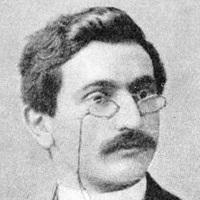
The Endgame Cunning of Emanuel Lasker, Part 1
It has been said that the second World Champion, Emanuel Lasker, was unique among the top players of his time period in that he didn't create a chess school of thought. Others have said that he did create a school - the "psychological school." It is strange, as a person who had ambitions as a mathematician and as a philosopher, that he would be the one to approach chess as a pure game.
I guess you could say that Lasker kept chess as it was meant to be. In the earliest days of chess, before there were even real tournaments, it was natural to think of chess as a game of cunning - where you try to out think your opponent - rather than as a science where you can discover some new principle and defeat everyone as if by a magic bullet. Lasker, of course, accepted and used the new (at the time) conceptions of chess - for example, those of Steinitz. He set his mind to finding the truth in each position - but at the same time, he understood that every game is ultimately decided by cunning and trickery.
One hundred years ago, Lasker competed in the St. Petersburg 1914 tournament after an absence from serious chess of four years. Having been world champion for already twenty years, you wonder how Lasker maintained the ambition and will to fight. But in fact, for one of the first times he was beginning to face real challengers - there was Akiba Rubinstein, the young Russian player Alexander Alekhine, and - most of all - the Cuban player José Raúl Capablanca, with whom Lasker was not on good terms due to disagreements about negotiations for a world championship match.

José Raúl Capablanca | Image Wikipedia
The St. Petersburg 1914 tournament consisted of two phases. First, a round robin tournament between the eleven players, after which the top five would play a double round robin (each player plays the others twice) among themselves. Although the preliminary part was a qualifier for the second, the scores that each player made would carry forward to the final. This format was supposed to provide the clearest test of who is the strongest player, as well as create the most drama - at the end of the tournament, the situation would not arise where the leaders ended up playing 'outsiders;' instead, they would be facing each other head to head near the end of the tournament.
Lasker began quite poorly, and after his unexpected blunder in a better position against Osip Bernstein, had only four out of seven. It was not clear whether he would even be able to qualify for the final.
By defeating David Janowski and Isidor Gunsberg in the last two rounds of the preliminary, Lasker just managed to qualify. Akiba Rubinstein - although many saw him as a heir apparent to the world championship - tragically started the tournament poorly and was unable to qualify.

Nevertheless, the chances of Lasker winning this important tournament seemed slim. At the start of the final, Capablanca led the field with eight points. Lasker and Siegbert Tarrasch were his nearest pursuers, with six and a half each. A lead of one and a half points seemed insurmountable, especially with Capablanca playing stellar, machine-like chess.
Lasker began his battle for first place in the final with a win against Alexander Alekhine. The young master chose the Albin counter-gambit, and was soundly beaten. In the following round Capablanca nearly managed to put the tournament away with a victory against Lasker himself. However, Lasker managed to dig in and finally hold the draw after 100(!) moves.
Despite this close call, Lasker was playing to his full abilities in the final. In the next game he won a subtle positional game against Tarrasch; in the round after he defeated Marshall in a sharp and modern-looking game. This does not fit my subject matter, since the queens (at least, Marshall's queen!) stayed on the board until the end. However, I will show it here without notes. With the exception of the choice of the rather unpopular Old Indian Defense (which was at the time considered to be a highly irregular and modern opening), you can easily imagine this game played by today's young masters:
And yet, despite these fine games, Lasker had only managed to creep one half-point closer to Capablanca, who now had 11 points against Lasker's 10. Meanwhile, four rounds had gone by, and there were only four left.
In the following round, Lasker once again defeated Alexander Alekhine. In the exchange variation of the Spanish, Lasker (Black) seemed to have a precarious position - but this was an illusion. With subtle tactics Lasker managed to clarify the position with a small advantage. Nevertheless, Alekhine had excellent chances to hold, especially considering the limited material on the board. But in a manner similar to Magnus Carlsen nowadays, Lasker used every available tactic to keep white under pressure, eventually managing - with a clever and surprising move - to win the exchange. That was not the end, however, as Lasker had to use all of his persistence to extract a win in the resulting ending.
An enormous battle, in which Lasker's will to win finally brought him the point. But even after this, he still had not drawn level with Capablanca. Although both players had eleven points, Capablanca had already had his bye, and thus had four more games to play, while Lasker only had three. So in effect, Capablanca was still ahead by at least half a point. Their meeting on the following day would prove crucial - for that, check out next week's article.
RELATED STUDY MATERIAL
- Read more about Lasker from IM Silman in Emanuel Lasker, Tactical Monster - Part 1;
- Check out a skittles game Capablanca and Lasker also played in 1914 in this Chess Mentor course;
- Keep your tactical eye open with our Tactics Trainer;
- Get inside Lasker's head in GM Dejan Bojkov's video Greatest Chess Minds: Emanuel Lasker - Part 1.






